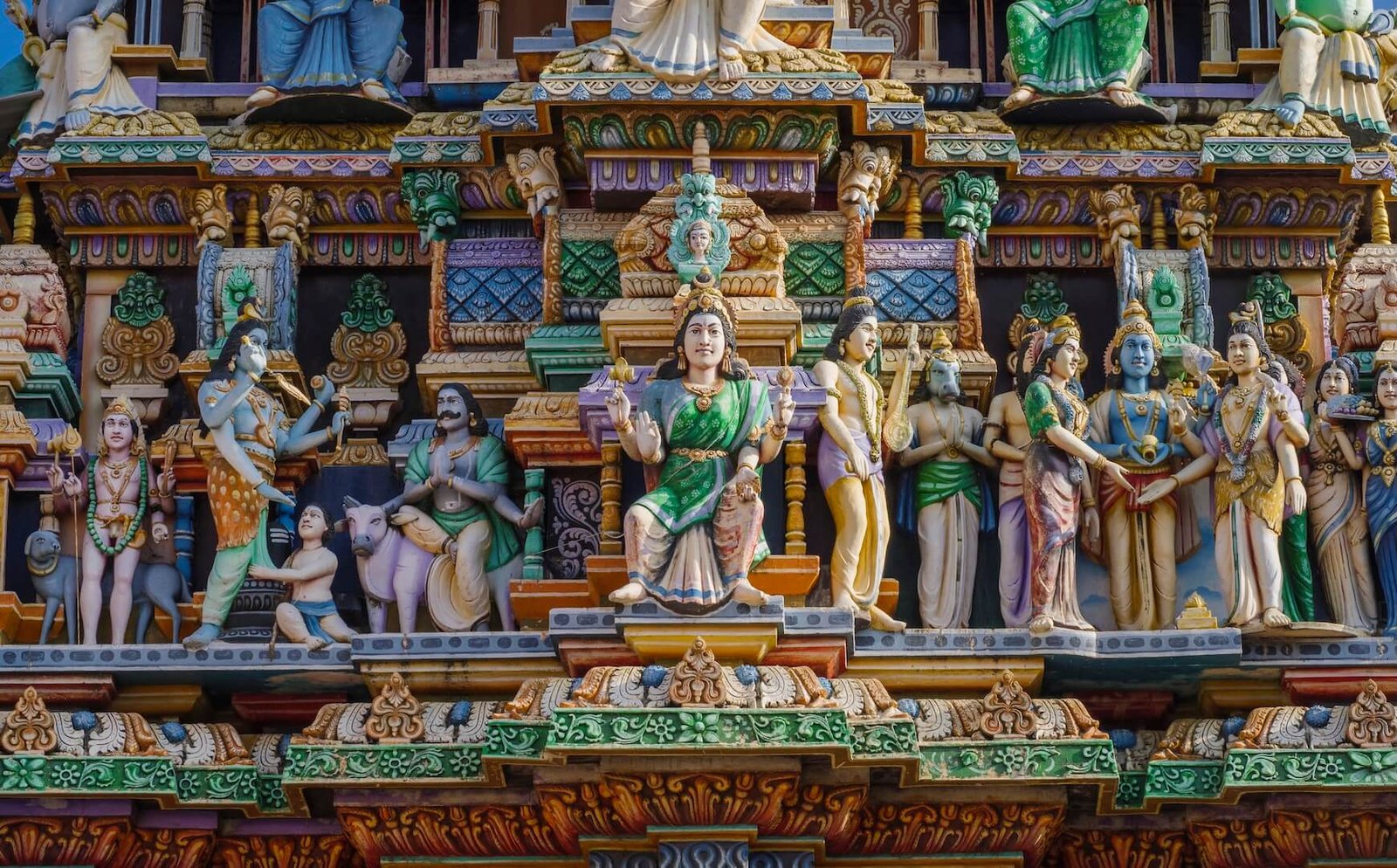Sri Lanka is often celebrated for its ancient Buddhist heritage, but it also has a rich Hindu tradition that predates colonial history and continues to thrive. About 12 percent of the population identify as Hindu, with most communities living in the northern and eastern provinces and in the central tea country. Their temples (called kovils) and festivals add colour to the island’s cultural tapestry. Whether you’re a pilgrim seeking blessings or a traveler keen to understand Sri Lanka’s diversity, visiting these sacred sites offers insight into faith, architecture and living history.
Hinduism in the Sri Lankan Context
Hinduism arrived in Sri Lanka through trade and migration from South India long before recorded history. Early Tamil dynasties introduced Shaiva traditions (worship of Lord Shiva) and built shrines dedicated to deities such as Murugan (Skanda), Vishnu, Kali and Amman. Over centuries, Tamil and Sinhalese Buddhists coexisted, exchanging customs and even sharing sacred spaces. Many Sri Lankan kovils still exhibit Dravidian architectural features — towering gopuram gatehouses, pillared halls and intricate stone carvings. Today, Hindu temples stand alongside Buddhist dagobas and Islamic mosques, illustrating the island’s pluralism.
Ceremonies and festivals remain essential to Hindu social life. Thai Pongal, a harvest thanksgiving held every January, sees families cooking pots of sweet rice to honour Surya (the sun god). Maha Shivaratri in February or March is dedicated to Lord Shiva and celebrated with night‑long vigils and devotional songs. Navaratri, a nine‑night festival honouring the Divine Mother, fills homes and temples with music and dance. The most widely observed Hindu holiday is Deepavali (Diwali), the “Festival of Lights,” when oil lamps are lit to signify the victory of light over darkness. Local temples also host annual ther (chariot) festivals featuring processions, drumming and traditional dances. Respectful travellers are welcome to join these vibrant events, but should follow dress codes and customs.
Iconic Hindu Temples and Kovils
The following temples — many centuries old — are among Sri Lanka’s most revered. A visit to these sites illuminates history, artistry and devotional practices. Remember to dress modestly (shoulders and knees covered), remove shoes, and ask before taking photos.
Nallur Kandaswamy Kovil (Jaffna)
Located in the heart of Jaffna, Nallur Kandaswamy is one of Sri Lanka’s most important Murugan temples. It was originally founded in the 10th century, destroyed by the Portuguese in 1624 and rebuilt in 1734. The temple complex features massive gopurams (gateway towers), multiple sanctums and a golden chariot used during the fifteen‑day annual festival in August. Devotees flock from across the island for processions, traditional drumming and the dramatic vel (spear) ceremony. Visitors must wear white or light‑coloured clothing, and men are expected to remove their shirts before entering the inner sanctum.
Koneswaram Temple (Trincomalee)
Perched atop Swami Rock above the Indian Ocean, Koneswaram Temple is part of the famous Pancha Ishwaram — five ancient Shiva shrines in Sri Lanka. Known as “Dakshina Kailasa” (Kailash of the South), it overlooks Trincomalee’s natural harbour and offers breathtaking views. According to legend, the original temple dated back over 2,000 years and housed a thousand‑pillared hall; it was destroyed by the Portuguese in the 17th century and later rebuilt. Pilgrims today follow a path through shrines dedicated to Shiva, Parvati, Ganesh, Vishnu and Murugan before reaching the cliff‑top main sanctum. The temple’s annual Ther Thiruvila festival (usually April) includes boat processions in Back Bay and draws devotees from Tamil Nadu and beyond.
Thiruketheeswaram Temple (Mannar)
On the wind‑swept shores of Mannar lies Thiruketheeswaram, another Pancha Ishwaram shrine. Overlooking the ancient port of Manthai, this temple is believed to date to at least the 6th century BC and is mentioned in early Tamil literature. It prospered under Pallava, Pandyan and Chola rulers before being destroyed by the Portuguese in 1575. After centuries of neglect, the Tamil philanthropist Arumuka Navalar spearheaded its reconstruction in 1903. Today, pilgrims worship Shiva at the rebuilt complex and visit the adjacent Palavi water tank, whose sacred waters are said to have healing properties. The temple is also one of the 275 Paadal Petra Sthalams praised in Tamil hymns.
Naguleswaram Temple (Keerimalai)
Near the northern tip of the island, the Keerimalai Naguleswaram Kovil sits beside mineral‑rich springs believed to cure ailments. This temple is the northernmost Pancha Ishwaram and has been venerated since classical antiquity. Devotees honour Lord Shiva and bathe in the Keerimalai Springs, especially during the Aadi Amavasai festival in July/August, when Hindus perform rituals for departed ancestors. Legends say a sage with the face of a mongoose (nagulam) was transformed back into human form after bathing here, hence the name “Naguleswaram.”
Munneswaram Temple (Chilaw)
Munneswaram is a sprawling temple complex near Chilaw in the North Western Province. With origins dating back over 1,000 years, it is entwined with the Indian epic Ramayana; some believe the hero Rama prayed here after defeating the demon king Ravana. The complex comprises five temples, including a central Shiva shrine, a Kali temple frequented by Buddhists, and smaller shrines for Ganesh and Aiyanar. Munneswaram is best known for its month‑long festival in August, culminating in a grand chariot procession and a coconut‑smashing ceremony symbolising the destruction of ego. Because the temple serves both Tamil Hindus and Sinhala Buddhists, it’s a compelling place to observe multicultural worship.
Kataragama Temple (Kataragama)
Nestled in the deep south, Kataragama is a unique multi‑religious pilgrimage town. The main temple honours Skanda–Kataragama Deviyo (another form of Murugan) and is revered by Hindus, Buddhists and some Muslims. According to legend, Murugan married the forest maiden Valli here. Pilgrims often undertake arduous foot journeys to Kataragama, especially for the July/August Esela Perahera festival, which features night‑long processions, fire‑walking and vigorous devotional dances. Within the same complex stands a Buddhist stupa called Kiri Vehera and a mosque dedicated to al‑Khidr, exemplifying Sri Lanka’s interfaith harmony.
Maviddapuram Kandaswamy Temple (Jaffna Peninsula)
This temple near Keerimalai is associated with a touching legend. An 8th‑century Chola princess suffering from a skin disease prayed at the shrine and was miraculously healed; she then commissioned the temple to honour Lord Murugan. The present‑day structure dates to the 17th century and features the largest temple chariot in Sri Lanka. During the annual festival, the towering wooden chariot carrying the deity is pulled through the streets by devotees. Located close to Palaly airport, the temple is accessible by road and makes an excellent stop while exploring the Jaffna peninsula.
Sri Ponnambalam Vanesar Kovil (Colombo)
Tucked away in the bustling Kotahena district of Colombo, this remarkable temple is built entirely of dark granite. Constructed in the early 20th century by nationalist leader Sir Ponnambalam Ramanathan in memory of his father, the kovil follows South Indian temple architecture with finely carved pillars, intricate friezes and a towering gopuram. Dedicated to Lord Shiva, it is one of the city’s most serene religious sites. Visitors should observe the strict dress code (knees and shoulders covered) and note that photography is generally prohibited inside.
Sri Kailasanathar Swami Devasthanam (Captain’s Garden Kovil, Colombo)
Believed to be Colombo’s oldest Hindu shrine, this temple sits near the Beira Lake and is locally called Captain’s Garden Kovil. It is dedicated to Lord Shiva and Ganesha and was likely built during the Dutch colonial period by Indian merchants. The temple’s colourful façade, ornate statues and annual chariot festival (typically around February/March) make it a lively place of worship. Because it is hidden down a narrow lane, many travellers are surprised to find such an impressive kovil in the heart of the city.
Muthumariamman Temple (Matale)
In the central hill town of Matale stands the Muthumariamman Kovil, a dazzling testament to Dravidian art. Dedicated to Goddess Mariamman — protector against disease and bringer of rain — this temple is famous for its 55‑metre‑tall gopuram adorned with hundreds of vivid statues of gods, goddesses and mythical creatures. The main festival occurs in June and July when women carry pots of boiling milk on their heads and men perform fire‑walking rituals. It’s one of the best places to witness the fervour of rural Tamil Hindu worship.
Seetha Amman Temple (Nuwara Eliya)
Located in the village of Seetha Eliya near Nuwara Eliya, this colourful temple is said to mark the spot where Princess Sita was held captive by the demon king Ravana, as narrated in the Ramayana. A small stream beside the temple is believed to be where Sita bathed. The kovil is dedicated to both Sita and Lord Rama and features statues depicting scenes from the epic. Visiting Seetha Amman offers a blend of mythology and scenic beauty, as the temple is surrounded by misty hills and dense forest.
Tenavaram Temple (Dondra/Tondeswaram)
At Sri Lanka’s southernmost tip near the town of Dondra once stood Tenavaram Temple — known in Tamil as Tondeswaram — another member of the Pancha Ishwaram. It served as a major port‑town temple complex dedicated to Shiva and Vishnu. The Portuguese destroyed most of the original structures in the 16th century, but a modern shrine marks the site. Pilgrims still visit to pay respects, and the ruins hint at the temple’s former grandeur, which included Dravidian‑style gopurams facing the sea. Combined with visits to nearby beaches and the Dondra Lighthouse, Tenavaram offers both spiritual and scenic rewards.
Planning Your Kovil Tour: Practical Tips
- Dress respectfully: Both men and women should wear clothing that covers shoulders and knees. Some temples require men to remove shirts inside sanctums.
- Remove shoes: Footwear must be left outside most kovils. Bring socks if you’re sensitive to hot stone floors.
- Photography etiquette: Many kovils prohibit photos inside sanctums. Always ask permission before taking pictures of people or rituals.
- Check timings: Temples usually open in the early morning and late afternoon. Festivals and puja times vary; plan ahead if you want to witness specific ceremonies.
- Respect rituals: Avoid pointing feet towards deities, don’t touch shrines or offerings, and stand aside during worship. Silence or hushed voices are expected inside sanctums.
- Travel logistics: Some kovils, such as Naguleswaram and Thiruketheeswaram, are in remote areas. Hiring a car with a local driver or booking a guided tour ensures easy access and cultural insight.
Why Book a Hindu Heritage Tour with Us?
Exploring Sri Lanka’s Hindu temples offers a deeper understanding of the island’s multicultural identity. While many travellers focus solely on beaches and wildlife, a kovil tour reveals history, architectural artistry and living traditions. Our travel agency designs personalised itineraries that combine major temples with lesser‑known shrines and local experiences. We handle transportation, knowledgeable guides, accommodation and festival scheduling so you can focus on immersion. Whether you want to witness the grand Nallur festival, meditate beside ancient springs in Keerimalai or trace the Ramayana trail from Seetha Eliya to Sigiriya, we curate journeys that respect local customs and match your pace.
Conclusion
Sri Lanka’s Hindu heritage is as old as its limestone cliffs and as vibrant as its mango festivals. Temples like Koneswaram and Naguleswaram overlook endless seas, while hill‑country shrines such as Seetha Amman glow against misty green peaks. Visiting these sites invites you into a world of legends, community devotion and timeless architecture. As you traverse the island, let the fragrance of incense, the rhythm of drums and the sight of towering gopurams inspire reflection and appreciation. By travelling respectfully and engaging with local guides, you ensure that these sacred traditions endure for generations.

